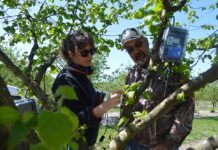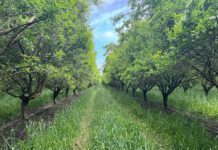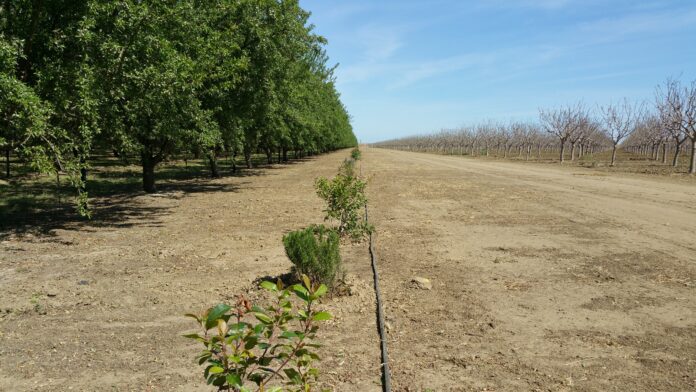
Adding one more thing to an almond grower’s plate may seem like pushing the envelope at this time. Already coping with higher input costs, pest pressure and environmental regulations, will growers be willing to take on a pollinator habitat project?
Permanent pollinator habitat is sited near orchards and consists of woody, herbaceous, perennial and annual species, often planted in a hedgerow. Plants provide nutrition, habitat and nesting space for managed bees and native pollinators. Impacts from insecticide or herbicide applications are lessened outside the orchard. Mature pollinator habitat can decrease soil erosion, increase water infiltration and help filter dust from farming operations. The site does not have to be large. It can be effective at 1% or less of the acreage.
“Conservation cover” or permanent pollinator habitat is like a cousin to a cover crop,” Stetcyn Maldonado of Seeds for Bees said. The organization, along with Pollinator Partnership and UC Davis researcher Neal Williams, is offering information to growers on siting, preparing and planting pollinator habitat. Grower incentives to establish permanent pollinator habitat are being offered by Blue Diamond and the Madera/Chowchilla Resource Conservation District.
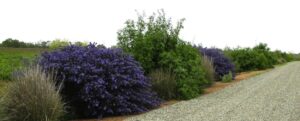
More Pollinator Visits
Williams, in a study funded by NRCS and USDA, found mature pollinator habitat attracted on average six times the number of native bees and three times the beneficial insect diversity compared to unplanted controls without attracting more pest insects. These benefits can extend to increased yields in crops, including California almonds.
The added nutrition source, researchers report, will help with hive strength and increased numbers of native pollinators, which contribute to pollination and crop yield.
Maldonado confirmed hedgerows of native plants planted near orchards attract beneficial insects, or natural predators of pest insects. Species native to California are likely to establish best as they are adapted to soil and climate conditions.
Williams, with funding from the Almond Board of California, is guiding habitat placement for pollinators and other beneficial insects in orchard landscapes.
His work helps to prioritize locations for habitat using spatial modeling and field validation to develop predictive maps. These can show where available uncropped land exists, even showing places where two or more growers can collaborate on the habitat and guide reduced pesticide risk management strategies.
Williams explained land use data can identify ‘land in between,’ parcels adjacent to orchards that are not farmed. These are good spots for pollinator habitat and can provide access to more than one orchard. The models also find larger orchard blocks. These are more suitable for mating disruption for navel orangeworm control and can rely less on insecticide application, lowering risk to bees and native pollinators.
Williams said his efforts are aimed at showing grower opportunities to increase pollinator habitat.
Billy Synk with Pollinator Partnership said more almond growers are seeing the value in habitat establishment. Thanks to incentive programs, he said more than 25 linear miles of hedgerow habitat has been planted in the last year.
Hedgerow plantings are favored, he said, because of low maintenance needs once established. He noted buying lower-priced small plants is not the best option for hedgerow habitat. The most cost-effective strategy, he said, is to buy the mid-size plants, plant them 6 to 10 feet apart and provide irrigation until established. Pollinator Partnership can also assist with identifying the most suitable plants for the site.
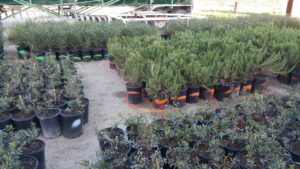
Weed Control a Must
Site preparation, including weed control, is important prior to planting. Solarization may be effective if site preparation is initiated during the summer months. It will not be successful if there is substantial infestation of hard seeded or rhizomatous weed species present.
Williams said ‘dealbreaker’ weeds at the proposed site include field bindweed, hairy vetch and mallows, which may need more time and herbicide applications to keep them from outcompeting young hedgerow plants.
He said if weed control was consistent during the first year of habitat establishment, less effort would be necessary in following years. Irrigation after favors weeds; drought can be one form of weed control in habitat plantings.
With mixed species plantings, sunny locations are favored by bees. If irrigation is possible due to a connection to an orchard it can help with timing of germination to manipulate bloom to support bees prior to almond bloom. Irrigation can also help if solarization of the ground is used for weed control.
The benefits of permanent habitats planted specifically to attract pollinators may be worth growers’ effort and the expense. Grower incentives to plant pollinator habitat near orchards are available. Both Natural Resource Conservation Service and Blue Diamond have new grant programs incentivizing pollinator habitat projects.
California Wildlife Conservation Board funding is being offered by Madera/Chowchilla Resource Conservation District. They are offering technical advice and help with the design and implementation of habitat projects, including hedgerows. Funding is available for site preparation, installation and materials like native plant plugs and seeds. They also provide ongoing monitoring and maintenance assistance.
Blue Diamond’s Orchard Stewardship Incentive Program (OSIP) goes one step further by delivering financial support to assist in the implementation of climate-smart stewardship practices. For Blue Diamond grower-members, this is an opportunity to receive their normal OSIP incentive and now also be reimbursed for implementing stewardship practices that may otherwise be cost-prohibitive.
Blue Diamond’s grower-members planted more than 100 acres of conservation cover in the first year of the project. Starting May 1, the cooperative began accepting applications from their approximately 3,000 grower-members for the second year of activities, which are supported by grant partners Project Apis m. and Pollinator Partnership.
Beekeeper Alicia Perez of Bee Happy Farms said beekeepers support pollinator habitat establishment alongside orchards.
“When we take our bees to the almond orchards, they not only do their job of pollinating the crop, they also receive the first round of nutrition from the cover crops or planted habitat. A good food source for our bees during this time is critical to increasing hive numbers for the year and maintaining the number of colonies needed for our apiary operations.
Perez said more diversity in nectar and pollen available for bees through cover crops or dedicated pollinator habitat increases health of bees.

Cecilia Parsons | Associate Editor
Cecilia Parsons has lived in the Central Valley community of Ducor since 1976, covering agriculture for numerous agricultural publications over the years. She has found and nurtured many wonderful and helpful contacts in the ag community, including the UCCE advisors, allowing for news coverage that focuses on the basics of food production.
She is always on the search for new ag topics that can help growers and processors in the San Joaquin Valley improve their bottom line.
In her free time, Cecilia rides her horse, Holly in ranch versatility shows and raises registered Shetland sheep which she exhibits at county and state fairs during the summer.








